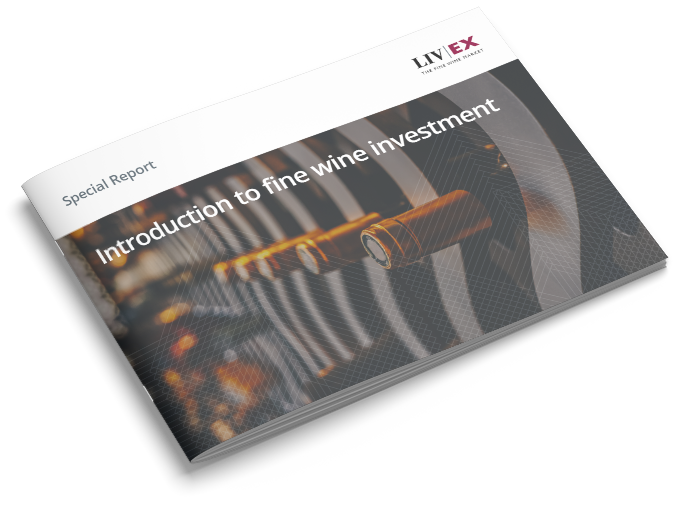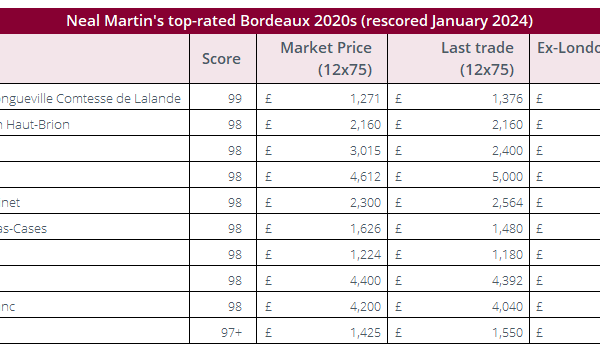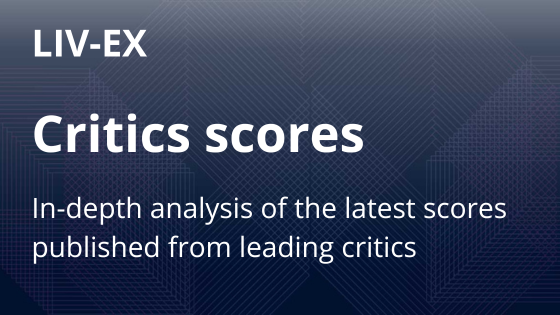On Wednesday we published the first part of Liv-ex’s interview with Lisa Perrotti-Brown, wine critic and Editor in Chief of Robert Parker’s Wine Advocate and eRobertParker.com. In part one, Lisa described her unlikely entry into the wine world and which wines from Australia were exciting her the most. In the second part, published below, she discusses being a woman in the wine trade, the competitive world of wine criticism and what will happen to the Wine Advocate when Robert Parker retires.
The wine trade is a traditionally male-dominated industry. What’s your experience of this and how it’s changed in the last couple of decades?
It is an issue. When I started out in the early 1990s the British wine trade was even more male-dominated. We’re getting better: there’s been a breaking down of those barriers. Having somebody like Robert Parker hire a woman on his review team was a big step. One of the first things I did was hire another one, when I brought Monica on board. She was the best woman for the job, the best person for the job. Whenever we need a new reviewer we scour the world and all of the experts within the area for the regions we’re looking at. Now we’re very much blinded to male / female: I never, ever think like that. But having worked in the wine trade for a long period of time I know it’s often the first consideration when people want to hire someone: they know what they want, and it’s usually a man. It takes a lot of convincing on a woman’s part to live up to that image that somebody might have. Now why is that? There are lots of reasons, I suppose. You’re dealing with a product that traditionally has an image of an old boys’ club. But at the Wine Advocate we’re an eight-strong review team, and two of us are women.
How does the review process work, in terms of ensuring consistency across those eight reviewers?
We’re well aware that we’re not identical carbon copies of each other and we don’t have exactly the same palates: nobody does. That said, we try to use objective criteria when we’re looking at quality. Some people are harder on their scores, some are more generous. Ultimately we’re individual critics who are experts within the regions that we review and we taste across a peer group. We’re in a unique position to make judgement-calls based on our experiences. It’s not as simple as looking at, for example, my scores for Australia and Bob’s scores for Bordeaux 2009 and saying, “He’s more generous.” Because he’s looking within the context of a region, style, vintage, and making calls.
Can people compare your 95 points for one wine to 95 points for another wine?
They should be able to do that. 95 points should be a standard level in and of itself. In an ideal world, it should also translate across reviewers. Bob’s 95 should be the same as my 95 – we’re aware it doesn’t work out like that, but it’s what we strive for.
It was recently announced that Parker will step down from tasting En Primeur this year, to be replaced by Neal Martin. How will these reviews fit into the Wine Advocate?
When Neal’s reviewing Bordeaux 2014 this year it will be part of the Wine Advocate. He still has that little area, Wine Journal, where he can write off-the-cuff opinion pieces and reviews. Neal has reviewed Bordeaux for 18 years now: it’s been great for him doing Bordeaux and maintaining that consistency. I first met him in Bordeaux when I was at Corney and Barrow many years ago. He used to look like Harry Potter… I remember he was so passionate about Bordeaux, even back then. And so knowledgeable. I look at where he’s come to since then, and he was our natural fit and we were very fortunate to have that.
The Wine Advocate calendar shows that Parker will be tasting the 2012s in bottle and then doing a Bordeaux 2005 retrospective. What else will he be doing?
The 2012s we’re hoping and praying to get in the end of April issue and then the 2005s he’ll probably taste soon afterwards, but I’m not planning it until the June issue. Then I need to pin Neal and Bob down: both have great plans. We want to do more Bordeaux coverage; more verticals of chateaux, more retrospectives.
One day Parker will retire. Does wine criticism then become a more competitive world? There has already been the Stephen Tanzer and Antonio Galloni merger.
I was just talking to a few of the reviewers about that this morning. It’s gone kind of quiet again, hasn’t it?
It’s already a competitive world for us. Much more so than when Bob first started 38 years ago. So much has happened to wine criticism, wine reviewing, wine writing, the advent of wine bloggers. We don’t have to wait until Bob retires, and he’d be the first to say this. But we stick to our guns, which are the cornerstones that Bob set up: our integrity, making sure that we aren’t compromised in our views, and supporting our reviewers to go out there and make their own opinions. Readers can read the marketing spiel of wineries on any wine website in the world these days. What they can’t get – and what they need – is expert opinion: what does the vintage bring, what does this change in winemaking mean, what are the trends? We need opinions and this is what we sell. We’re trying to be much more comprehensive in the number of tasting notes we do.
The Wine Advocate has a lot of content – where do your subscribers start?
This is a question that we ask ourselves. We are readers as much as we are producers of this content. We are working so hard behind the scenes to develop a new way of packaging stuff because we need to package it better – we’re painfully aware of that. Last year we produced 29,642 tasting notes and in 2011 we produced about half of that. We’ve grown enormously. But we need to package it better, to present it better. Not only on the website itself but in the digital format, which we’re working on, and print formats, so that people can enjoy them rather than just see it as a tsunami of tasting notes coming at them each month. Very soon we’ll be launching a new website that hopefully brings all this great content to life and makes it more fun and easy to read.
What about the competition posed by peer-to-peer sites such as Cellar Tracker?
I think there’s room for both. As much as being an editor and writer of content, I love to read. I love to read all of the random reviews by consumers. Some of them you have to take with a pinch of salt and some of them are probably pretty accurate. We can’t taste all of the wines all of the time.
How many wines do you think the consumer tastes in a year? Is there any virtue in a tighter set of notes and scores?
We don’t expect our readers to read every single tasting note. There is virtue in a tighter set. When my reviewers are feeling overwhelmed because everyone and their dog wants tasting notes, one of the things I say is, “Part of your job is selection. You can’t taste everything, and our readers don’t want to read everything. They want you to pick the best out and talk about those benchmarks out there.”
Are we ever going to run out of scores? When are we going to hit the first 101?
Or 100+…. I don’t think we are going to run out of scores. When you get into those upper echelons it’s not just about having a flawless wine, having a wine that ticks all of the boxes. You come to this level of complexity and expression of time, person and place that is always going to be a very rare thing.
You’re here in London for a Matter of Taste [the event was held at the Saatchi Gallery on Saturday 28th February] – can you tell us a bit about that?
We started up in Singapore in November then we did a smaller version of Matter of Taste in Kuala Lumpur. Those went really well, the same kind of formula as we’re doing here with the walkabout tasting and the masterclasses. London is bigger. It’s grown enormously: the event began to take on a life of its own. We were anticipating we’d do 300 wines. We went to our reviewers and asked what wines they’d like to share from their regions, and from there it snowballed. So from 300 wines we’re now showing 672 wines. We’re doing a loose theme around greatness, so people have a real opportunity to taste wines across a wide range of styles but all a very high level of quality. It works really well because it gives people the opportunity to gravitate towards some of their old favourites, and the classic regions, but also to branch out to some new and quirky things.
What’s the future of the Wine Advocate?
The new website, and the events we’re doing to get closer to the customers. We’re touring every year – not always as a full team but at least as a partial team, or a full team when we’ve got a bigger event like London or New York.
I think we’ve got enough team members now – it’s quite a juggle for me. We weren’t even able to get together last year because I was pregnant. I did a little a tour with Bob in the early part of the year with a big tummy, then gave birth in June, was grounded for a few months and then started travelling again. So we missed our annual meeting. This year we were so gung ho to see each other. Now we’ve started doing the Matter of Taste events we can get together for a reviewers’ meeting, a reviewers’ dinner. We actually really, really get on as a team.
The Wine Advocate now has a Singapore-based owner and Singapore-based Editor in Chief. Is your readership growing faster in Asia?
It is growing faster in Asia than it is elsewhere. Saying that, we absolutely understand the importance of our American core. Asia was always going to be easier for us to tackle because the events are smaller by nature, great for getting down the format of what we wanted to do for things like A Matter of Taste. We haven’t been so much focusing our efforts on Asia but we’ve been saving up our efforts for getting everything perfect in both London and New York.
So are we going to have a Chinese version of The Wine Advocate one day?
Maybe not a complete Chinese version but we are looking at translations now. Not just Chinese either – we’re looking at some of the European languages too.
To read the first part of Lisa’s interview, please click here.





